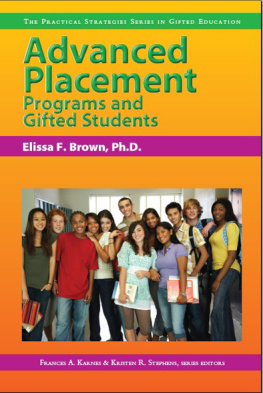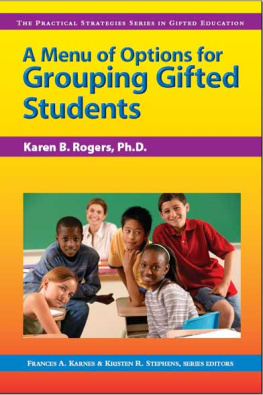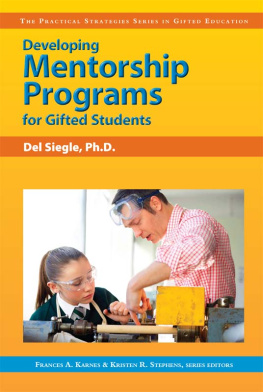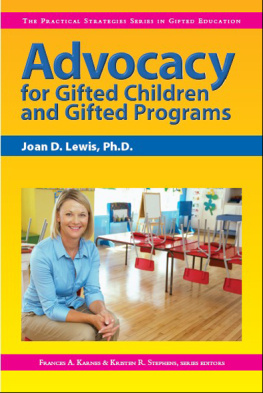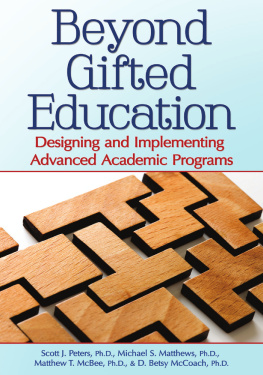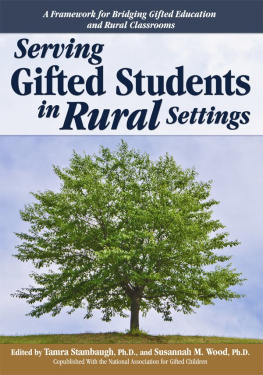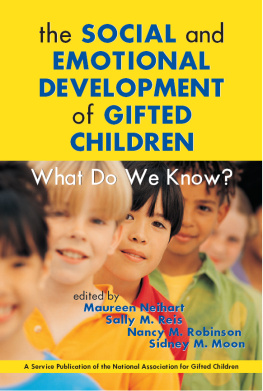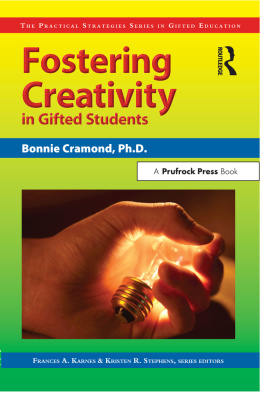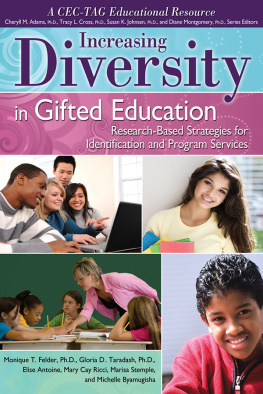FRANCES A. KARNES & KRISTEN R. STEPHENS
Advanced Placement Programs
and Gifted Students
Elissa F. Brown, Ph.D.

P RUFROCK P RESS I NC .
Copyright 2010 by Frances A. Karnes
and Kristen R. Stephens-Kozak
All rights reserved.
No part of this book may be reproduced, translated, stored in a retrieval system, or transmitted, in any form or by any means, electronic, mechanical, photocopying, microfilming, recording, or otherwise, without written permission from the publisher.
Printed in the United States of America.
ISBN-13: 978-1-59363-775-0
At the time of this books publication, all facts and figures cited are the most current available. All telephone numbers, addresses, and Web site URLs are accurate and active. All publications, organizations, Web sites, and other resources exist as described in the book, and all have been verified. The author and Prufrock Press Inc. make no warranty or guarantee concerning the information and materials given out by organizations or content found at Web sites, and we are not responsible for any changes that occur after this books publication. If you find an error, please contact Prufrock Press Inc.

| Prufrock Press Inc. P.O. Box 8813 Waco, Texas 76714-8813 Phone: (800) 998-2208 Fax: (800) 240-0333 http://www.prufrock.com |
Series Preface
The Practical Strategies Series in Gifted Education offers teachers, counselors, administrators, parents, and other interested parties up-to-date instructional techniques and information on a variety of issues pertinent to the field of gifted education. Each guide addresses a focused topic and is written by an individual with authority on the issue. Several guides have been published. Among the titles are:
- Acceleration Strategies for Teaching Gifted Learners
- Curriculum Compacting: An Easy Start to Differentiating for High-Potential Students
- Enrichment Opportunities for Gifted Learners
- Independent Study for Gifted Learners
- Motivating Gifted Learners
- Questioning Strategies for Teaching the Gifted
- Social & Emotional Teaching Strategies
- Using Media & Technology with Gifted Students
For a current listing of available guides within the series, please contact Prufrock Press at 800-998-2208 or visit http://www. prufrock.com.
Introduction
The predominant service delivery option for secondary gifted students in Americas high schools for the past two decades has been Advanced Placement (AP) and International Baccalaureate (IB) programs (Callahan, 2003). The AP program was developed by the College Board in the mid-1950s and was never intended to be specifically for gifted students. At its inception, the AP program enrolled about 1,200 students; however, today the program boasts more than 1 million students. Similarly, the IB program, introduced in the early 1970s, enrolls more than 30,000 students nationwide (International Baccalaureate North America, 2004). For thousands of students, the courses associated with these two programs represent the first time in which they feel academically challenged, are taught by teachers with great depth of content knowledge, and are in an enriching and comfortable learning environment. Students do not have to be formally identified as gifted to enroll in either AP or IB courses; however, some schools or school systems do establish criteria to determine student readiness for participating in these courses. provides the purpose and criteria for eligibility for both the AP and IB programs.
Table 1
Purpose and Criteria for Advanced Placement and
International Baccalaureate
| | |
|---|
| Program | Purpose | Criteria for Eligibility |
|---|
| Advanced Placement | To provide high-achieving and self-motivated students opportunities to enroll in advanced courses of study and have the opportunity to earn college credit and/or advanced placement while enrolled in high school. | Eligibility is determined by Preliminary Scholastic Aptitude Test (PSAT) scores and students readiness to engage in postsecondary level work as indicated by subject-area teacher and previous performance. |
| International Baccalaureate | To provide an advanced level of high school coursework designed to meet various international university entrance standards.
To provide highly motivated students from diverse linguistic, cultural, and educational backgrounds with the intellectual, social, and critical perspectives needed to excel in college and beyond. | Student must:
be enrolled in a school authorized by the International Baccalaureate Association (IBO), and
demonstrate high level of achievement or preparation at the middle school and pre-IB levels. |
The focus of this volume will be on the Advanced Placement program. It will address misconceptions about AP courses, the benefits of AP courses for gifted learners, suggested core and targeted teaching strategies for differentiation within AP courses, and supporting and impeding structures for implementing and sustaining a coherent AP program within a high school program of studies.
Misconceptions About AP Courses
The AP program is intended to provide high school students with advanced content at the same level as an introductory college course. A typical introductory college course emphasizes breadth of content over depth because it is designed as a survey course, with the assumption being that students who wish to pursue a specialized domain within the content area will explore depth of content in upper level college courses, usually in their third or fourth year.
Mattimore (2009) cites four myths about AP courses:
- AP courses are about memorization and do not require students to think critically. Although AP exams do require students to understand basic facts within a particular area, students are expected to build upon this knowledge by making inferences, drawing conclusions, and analyzing patterns.
- High school teachers lack expertise to teach college-level classes. AP teachers are encouraged to receive specialized training though the College Board. The College Board offers hundreds of workshops each year for this purpose. In addition, teachers have access to college textbooks, manuals, test banks, and other resources that are similar to those provided to college professors.
- Awarding college credit reduces chances for wider intellectual exploration in college. On the contrary, AP courses allow students to bypass introductory courses that are sometimes required prerequisites and help broaden the college experience by giving students additional opportunities to delve further into a subject or pursue a double major.
- College courses provide greater intellectual breadth and depth than AP courses. Introductory college courses are typically lecture classes (sometimes large) where students have limited personal contact with the instructor. Sometimes a graduate student teaches these courses. AP high school courses are typically small, more personalized, and taught by a highly qualified AP teacher. Mattimore (2009) does encourage the College Board and colleges and universities to monitor AP classes to ensure that coursework is equivalent to college-level work.

